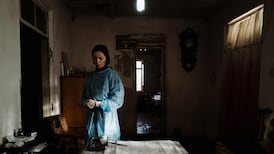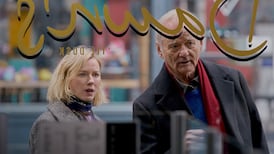It's not easy being one of the most beautiful women on the planet. No, really. Just ask Olga Kurylenko. At 33, the Ukrainian-born star of incoming sci-fi extravaganza Oblivion can attribute at least some of her international prominence to a physical appearance that has been in no way poked at with an ugly stick.
Aged 13, she was plucked from obscurity when a modelling agent spotted her at a Moscow underground station. It was, she says, a "crazy chance" – she just happened to be there on a day-trip with her mum; within three years, she was a Vogue and Marie Claire cover star.
Still, there are certain drawbacks to being a model-turned-actor.
“Definitely,” she interjects even before I can finish the much-maligned phrase. “Yes. It was harder. It doesn’t help. You have to prove yourself a little bit more. Everything you see is the result of a complicated process of script reading, hesitating, declining, and choosing. And choosing is hard. Sometimes it’s hard just saying ‘no’. You get a chance to do a movie with an actor or director you’ve always wanted to work with but the part is just arm candy. And it kills me. Euch! I want to work with this guy but I’m just not doing this. You have to be strong. You have to believe you’ll get your chance again with a better role and on your own terms.”
She has, understandably, been keen to avoid “Bond girl type roles” since she played Camille in 2008’s Quantum of Solace. Being a Bond babe, she concedes, isn’t necessarily as much fun as it looks.
“Don’t get me wrong,” she says. “The Bond film was a great experience and he [Daniel Craig] was great to work with. All the people I worked with on Bond were lovely. And I learned skills with guns and fighting that have been useful to bring into other films. It’s not a question of never doing something like that again. There are only so many genres. You will always get to a point where you are repeating yourself. But I really didn’t want to get stuck in that kind of role.”
Thus far, saying no to the "trashy stuff" seems to be paying dividends. Oblivion arrives on the back of appearances in Terrence Malick's To the Wonder and Martin McDonagh's Seven Psychopaths . There's also the day-job: Kurylenko is currently appearing on TV's Magic City alongside Jeffrey Dean Morgan and Danny Huston.
“I’ve had to decline a lot of parts,” she says. “And I’m sure I’ll make mistakes and have made mistakes. But I’m happy following my instincts, my gut.”
Oblivion is Kurylenko's most visible project since she left her Bond years firmly behind. The project began life as a graphic novel by Tron: Legacy director Joseph Kosinski and arrives in cinemas as an IMAX-ready spectacle with Tom Cruise attached. The newly appointed Irishman plays the last drone mechanic stationed on a post-apocalyptic earth. Andrea Riseborough co-stars as Her Indoors; Kurylenko is the mysterious survivor Tom brings home from work. Intergalactic insurrection and domestic strife ensues.
"We've seen post-apocalyptic films before but this is a bit different," says Kurylenko. "I watched Solaris twice in preparation for Oblivion . Because it felt – you know – right. They both deal with space and memory in a similar way."
She has always loved sci-fi and recalls being scared witless by Alien back in her native Ukraine: "I can see how one might not like the horror genre or certain kinds of comedy. But who doesn't like science fiction? It's so entertaining. We all want to know or guess at the future. It's a dream."
A cheer goes up outside the hotel. Olga Kurylenko smiles and gestures toward the window of her room: “Tom’s back.”
She admits she still has to catch herself when she finds herself, as today, at the centre of considerable hoopla. It’s nothing at all like her upbringing.
Olga Konstantinovna Kurylenko was born and raised in the Ukrainian port of Berdyansk. Her parents divorced shortly after her birth leaving Kurylenko’s mother, an art teacher, to share childraising duties with her grandmother, Raisa. The family’s small, four-room flat was shared with an aunt, uncle, grandparents and cousins. They mostly lived on cabbage and potatoes and knew well how to darn and mend. The collapse of the Soviet Union added further financial strain.
“The times became harder for people in the country,” recalls Kurylenko. “The shops were all empty. There was nothing to buy and nothing to spend. There were queues for everything. I was at school so my grandmother stood in those queues for hours to get a piece of bread or a sausage or a pack of sugar. Everything was deficit.”
Does she remember a corresponding cultural shift?
“Yes. I remember. I was a kid at school but there were small differences. I remember we stopped wearing uniforms and started wearing our own clothing. We were pioneers then one day – suddenly – we weren’t. But day-to-day, I kept doing all the same things I had been doing. Music. Ballet. Art school.”
She laughs: “We were doing all the same things but there was less talk about Lenin when we were doing them.”
Take out the Lenin and that all sounds like a very girlie education. Was that the case?
“Oh yes. I was a very girlie girl. As a girl – as a kid – I wanted to be more of a tomboy but my mum wouldn’t let me. She really loved me being girlie. She’d put big bows in my hair and dress me in the fluffiest dresses. I liked acrobatics and I wanted to study karate. But she insisted on ballet. I liked ballet – of course – but I always wanted to do something tougher.”
By 16 – after that chance encounter on the Moscow Metro – Kurylenko had relocated to Paris and was the family's primary breadwinner. She was lonely, particularly between modelling jobs, and soon found a refuge in the French capital's many cinémathèques. It started with the collected works of David Lynch; Lars von Trier's Breaking the Waves sealed the deal; Olga Kurylenko was a cinephile.
“Where I grew up, it was impossible to be a big movie kid,” she says. “We had no sources. First of all, it was Soviet Union so everything I saw growing up was a Soviet movie. They weren’t movies that meant anything to my generation. Later on, when I moved to France, people would be talking to me about all these classics and were always surprised I hadn’t watched them. That came later for me. I had a lot to discover. I became a total movie chick. I would see three movies a day. It was fun.”
Buoyed by her new passion, Olga presented herself to an acting agency shortly after her 2004 divorce from French photographer Cedric Van Mol. (She has since remarried – albeit briefly – to the mobile phone accessory mogul Damian Gabrielle.) Film work, she says, has allowed her to live out all her youthful tomboy dreams.
“I love doing action. I almost feel that filming action is better than watching action films. I shouldn’t say it but it’s true. Watching action is pretty pictures and having fun. Doing it is developing a new skill set and a rush of adrenalin.”
In this spirit, Oblivion sees Kurylenko riding on Tom Cruise's futuristic motorbike across the wilds of Iceland. She likes her fight craft and relishes the precision it demands.
"We had to rehearse, rehearse, rehearse," she says. "There's a lot of preparation on this kind of project because if something goes wrong on a movie like Oblivion , it could be very expensive to fix or reshoot. You're working with machines and stunts. Everything is checked and timed. Everything is perfect."
How very unlike her time on Terrence Malick's dreamy To the Wonder in which an emotionally retarded Ben Affleck must choose between two perennially spinning potential mates, as played by Kurylenko and Rachel McAdams. The director only shot Kurylenko's eyes during her audition and the finished picture is ethereal even by Malickian standards. What on earth were the film-maker's instructions?
“It was like a sort of dance and choreography,” says Kurylenko. “There was a lot of movement. Malick doesn’t like his actors to stop. He was always pushing us to keep moving, whether walking or running or turning. You know what the mood of the scene is and you know what the thought of the day is and you know what the characters are doing today. After that a lot of it is teamwork.”
It sounds pretty exhausting.
“You get through a lot of material,” says Kurylenko. “He tries to capture all versions of everything. So we try the same things over and over in different ways. That’s why a lot of it gets cuts out. He has so many options at the end of a shoot. But it feels natural. It’s a very natural world – houses, grass, trees.”
She smiles: “It’s not like being in space with Tom Cruise.”


















